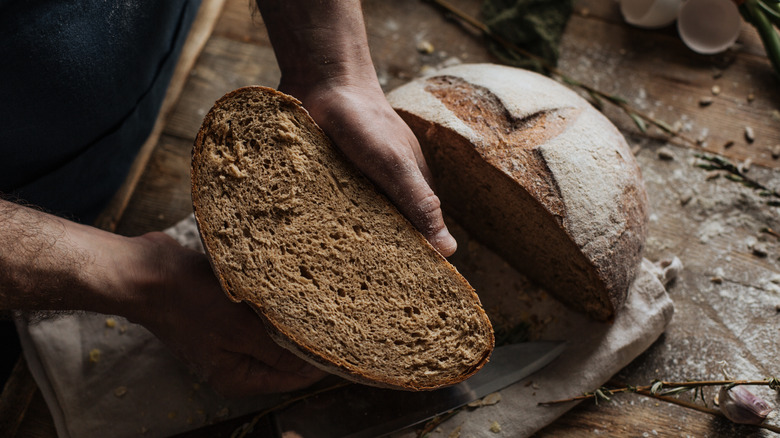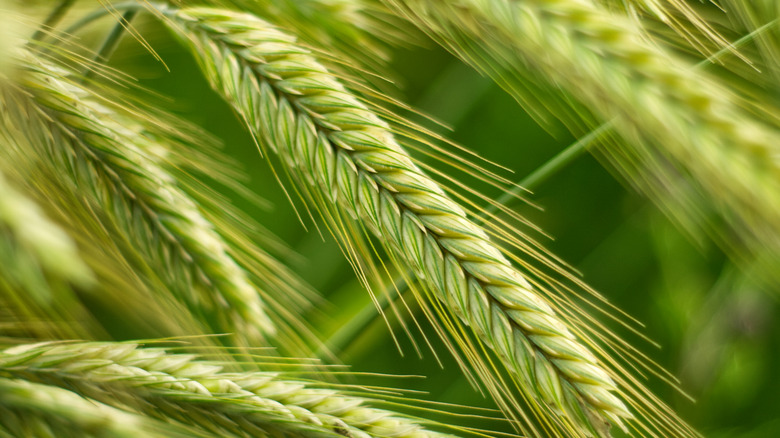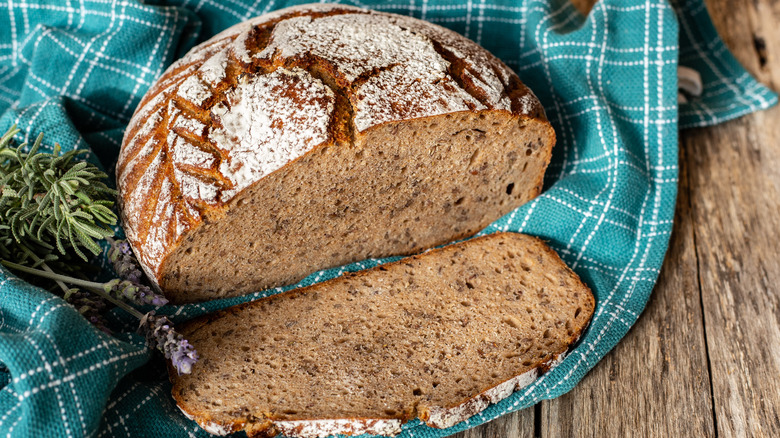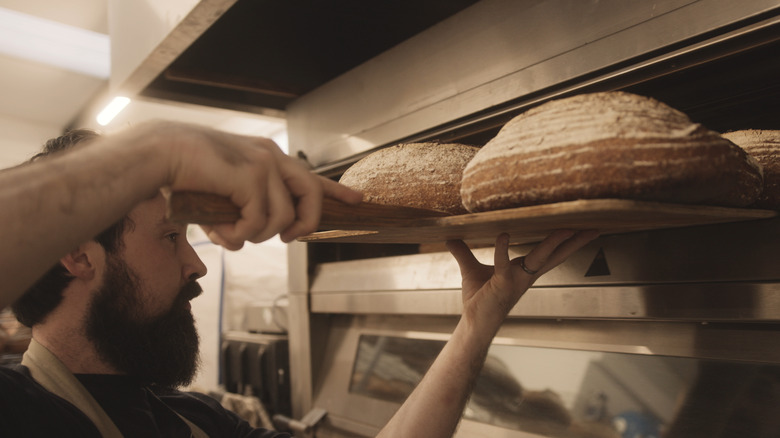What Is Jewish Corn Rye And What Does It Taste Like?
It might not be as polarizing as black licorice, cilantro, or blue cheese, but rye bread definitely has both fierce fans and firm haters. Though rye flour is not as strongly flavored as the caraway seeds that often stud slices of this bread, biting into one brings a shock of flavor that can be described as earthy, bitter, and anise-flavored that either intrigues the eater or completely turns them off. Known as the vehicle that holds together mountains of pastrami and towers of corned beef, rye bread is a Jewish specialty that bears the same cultural importance as matzo, challah, and bagels.
There is evidence that the ancient Mesopotamians may have made and eaten rye bread in the area now known as the Middle East. As Ashkenazi Jews made their way to areas like Russia and Northern and Eastern Europe, they discovered that the rye plant was cheaper and more plentiful than wheat, and thus, it went into their bread. Eventually, members of this diaspora immigrated to the U.S., where they opened up bakeries and delis of their own, which offered the public a taste of their culture and homeland. Rye bread was and is a staple offered at these types of businesses. If you've ever come across a loaf of corn rye in a Jewish deli, you may have wondered how it differs from a loaf labeled "rye" or "deli rye." It's basically the same thing, with corn playing an unexpected role. (We'll come back to that.)
The beginnings of rye bread
In the cold, wet areas of northern and eastern Europe, including Scandinavia and the Baltic countries, the rye plant thrives. The people who lived in these areas (Jewish or otherwise) created all kinds of breads using the ancient grain, including Scandinavian rugbrød, German pumpernickel, and Russian dark bread. As wheat became more popular throughout the world and agricultural technology improved, more wheat became available in areas that would've otherwise cultivated rye.
Whether it was deliberate or accidental, rye was commonly grown alongside wheat. The two grains ended up being harvested and processed together, creating what is known as maslin (flour made of both wheat and rye), otherwise known as the basis for basic rye bread. Jewish communities adored the breads that came from maslin, which offered the light, tender crumb of wheat bread with the flavor of the rye that they'd been eating for hundreds of years. When Europeans immigrated to America, their recipes came with them. As the mechanization around bread production improved, so did the amount of bread that could be made. The drawback was that it just didn't yield the result as traditional methods. Corn rye is, basically, the old-school version of rye bread.
How does corn rye taste?
One of the differences between mass-produced rye bread and an artisan loaf of corn rye is the amount of wheat flour used in each. Most American rye bread is comprised of mostly wheat flour and a small amount of rye flour to appeal to the masses' preference for softer bread. Eastern European rye would have had less wheat since it was more expensive than rye grain. To make corn rye, bakers follow tradition and use a combination of wheat and rye flour. Water, salt, yeast, and a rye starter round out the basic ingredient list, along with caraway seeds, which are optional.
The basic principles of bread making are followed, like preparing the starter a couple of days ahead of time and then adding it to warm water, yeast, and sugar. The flour is added to make a soft dough which is kneaded and rested a couple of times before being formed into boule-shaped rounds and baked. Where does the corn come in? Just at the end. The only corn present in corn rye is the cornmeal that dusts the bottoms of the loaves. Corn rye loaves should be dense with a sturdy, crisp crust. The inside should be soft and tender with an enticing, nutty aroma. Depending on whether or not caraway was added, you might get the sharp flavors of the seeds or not, but the gentle, malty flavor of rye should be present.
Where to get corn rye
With artisan bread-making on the rise and getting stronger, corn rye is available in larger numbers than it once was. Previously a dying bread variety, younger bakers are introducing corn rye to a whole new generation of consumers. You are most likely to find the loaves in areas with large Jewish populations, like New York City. It is available, for instance, at Russ & Daughters, which has several locations throughout the city.
Sometimes corn rye bread is used interchangeably with rye bread, so you may see loaves of it labeled as such at larger grocery chains. For artisan-style loaves, though, it's specialty markets or bakeries you'll want to seek out. If you don't live close to a business that sells them, you can order loaves online from places like Russ & Daughters or other bakeries that sell their bread through Goldbelly, like Orwasher's. Like all bread, corn rye is superb when eaten warm right from the oven, preferably with a large schmear of butter. Even if your loaf isn't freshly made, you can warm it up in your own oven. Bread also freezes well, so if you stock up, there's no need to fear your loaves going stale as long as you store them properly.



